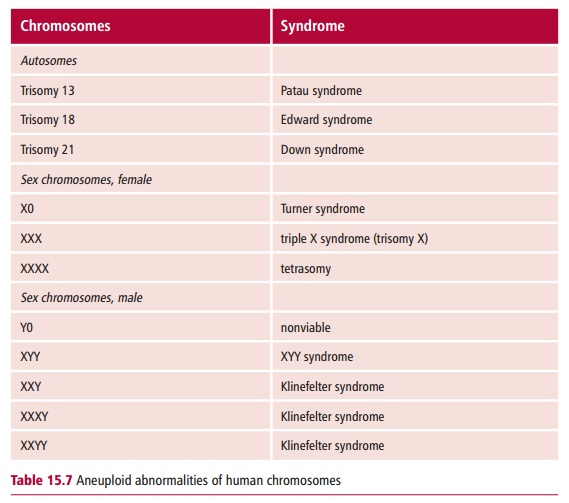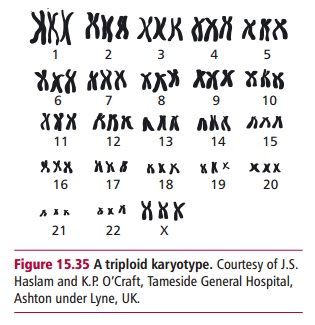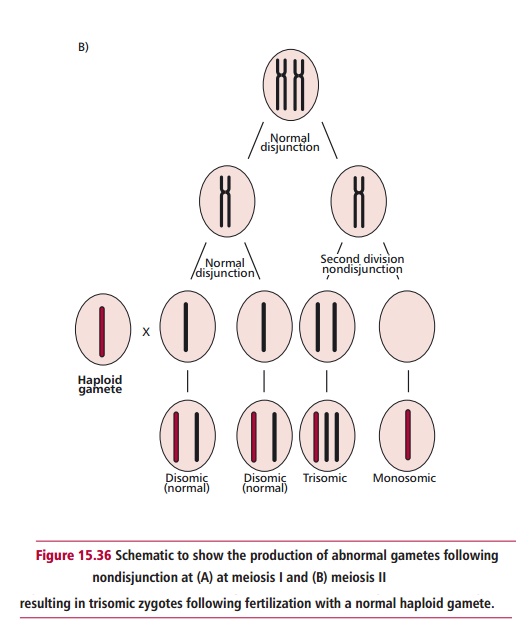Chapter: Biology of Disease: Genetic Diseases
Euploidy - Variations in Chromosome Numbers
VARIATIONS IN CHROMOSOME NUMBERS
Eukaryotic organisms are normally diploid and produce haploid gametes. However, chromosomal mutations with numerical aberrations in the number of chromosomes present occur. These can be divided into two major types. Aneuploidy occurs when the number of chromosomes differs in having more or fewer than an exact multiple of the haploid number of chromosomes. Table 15.7 lists a number of human aneuploid abnormalities of autosomes and sex chromosomes. In contrast, euploidy is the presence of an exact multiple of the haploid number of chromosomes.

EUPLOIDY
In monoploidy only a single set of chromosomes (23 in humans) is present, rather than the normal diploid two (46). Monoploid fetuses do not reach full term presumably because the recessive lethal mutations, which are usually counteracted by dominant alleles in heterozygous individuals, are expressed.

In polyploidy, the chromosome number is an exact multiple of the haploid number but exceeds the diploid number. Organisms with three sets of chromosomes are triploid (Figure 15.35), those with four sets are tetraploid and so on. Polyploidy usually arises from fertilization of the egg by two spermatozoa, which increases the total number of chromosomes to 69, or from a failure at one of the maturation divisions of the egg or spermatozoon so that a diploid gamete is produced. Thus if nondisjunction occurs at meiosis I, 50% of the gametes lack chromosomes and the other 50% have two sets of chromosomes (Figure 15.36). If nondisjunction occurs at meiosis II, 50% of the gametes possess the normal single set of chromosomes, 25% have two sets of chromosomes and 25% lack chromosomes (Figure 15.36). Fusion of a gamete with two chromosome sets with a normal gamete produces a zygote with a triploid set of chromosomes (3N). Similarly, fusion of two gametes, each with two chromosome sets, produces a tetraploid (4N) zygote. Polyploidy of somatic cells can also occur following the mitotic nondisjunction of complete chromosome sets.


Polyploidy normally causes an early spontaneous abortion and survival of the fetus to full term is rare. The commonest type of polyploidy in humans is triploidy. However, polyploids with an odd number of chromosome sets always possess an unpaired chromosome for each type, hence the probability of producing a balanced gamete is low. Indeed, triploidy in humans is always lethal and is seen in 15–20% of spontaneous abortions and in only about one in 10 000 births, where death invariably occurs within a month. Triploid babies show many abnormalities, including a characteristically enlarged head. Polyploids with even numbers of sets of chromosomes generally have a better chance of being at least partially fertile because there is the potential for homologous chromosomes to be segregated equally during meiosis. However, tetraploidy is also always lethal in humans and is seen in approximately 5% of spontaneous abortions. Very rarely, tetraploid humans are born although they only survive for a short time.
Related Topics